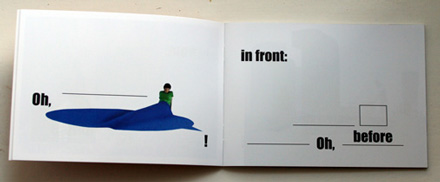 |
 |
|||||||||||
 |
 |
 |
 |
|||||||||
| Katalog Anna Gollwitzer
28 Seiten, Farbe Städtische Galerie Delmenhorst 2004 zur Ausstellung OH, WHAT A WORDWORKWONDER mit einem Text von Silke Feldhoff: wordworkwonder  |
||||||||||||
|
Buchansicht wordworkwonder dt. engl. pdf/engl. |
wordworkwonder ------------------------------- Ambivalent Objects of Fascination and Tautological Loops: Anna Gollwitzer’s Word Sculpture Scenarizations Anna Gollwitzer has confidence in the capacities of words - and yet she hardly trusts them a single inch. Dissociated from any concrete speaker, words always represent antagonists, to which Gollwitzer attends as objects of fascination that are endowed with thoroughly ambivalent qualities. Accompanying an interest in communicative processes that has conditioned her work for years - whether from cultural-sociological or psychological perspectives, or from those involving the philosophy of language - is a certain skepticism toward language and its uses, or more precisely: toward its powers to define, to attribute qualities, toward its frequently only hazily graspable emotive contents, and in particular toward the immanent ambiguity of the linguistic sign as such. A discourse about language, about communication, is always simultaneously a discourse about power. Anna Gollwitzer is a part of this discourse. Her words and punctuation marks occupy locations, framing, modifying, or imprinting themselves upon situations and preexisting contexts. To begin with, words always behave as though they were absolute and irrevocable, and this is true of Gollwitzer’s as well; but it turns out that in a sense, her word sculptures dwell in the midst of a multidimensional texture composed of reciprocally tensed relational axes, perspectival options, and (to a degree mutually antagonistic) levels of meaning – a fact that not only relativizes the above-mentioned claim to absoluteness, but also and more importantly incites visitors to reflect upon their own standpoints and to position themselves in relation to her word sculptures. Depending upon the relevant speech situation, the context, and on the mental states and the participants engaged in a given speech act, attributions are highly variable in meaning, and their contents can shift decisively. Still, we need them in order to reach an understanding, albeit mindful of the circumstance that any understanding can at most be provisional in character! Instead of illustrating the current language-philosophical discourse in visual terms, which would be unsatisfying, Anna Gollwitzer formulates an ANTAGONIST. She cites attributions as codifications in order to at least call into question certain social constructions and conventions (for language is these too), if not in order to break with them entirely. Anna Gollwitzer’s word sculptures are signs, that is to say: media of communication. They are stimulants to communicative processes. And their objects are conceived as partners in communication in relationship to which users will position themselves as parts of “wordworkwonder.” This practiced communication about communication constitutes an exquisite tautology and one that should be celebrated as a productive mental loop. Anna Gollwitzer’s analytical method aims to render language and communication intellectually graspable in their diverse facets, and beyond that, to make them corporeally and emotionally palpable. Through their sensual concretization, words become sculptures and signs in space - acquiring in the process the potential for being read as models of perceptions of reality, as instruments of analysis, or, as the artist expresses it, as “descriptive modules” of various thematic and formal constellations. That she asserts her position so confidently and as a matter of course within these discourses makes of Anna Gollwitzer’s “wordworkwonder” a persistent challenge to viewers _ and constitutes one of the essential artistic qualities of her word sculptures. “Language clothes thought. And moreover in such a way that we can draw no conclusions concerning the clothed thoughts on the basis of the outer forms of their garments.” (Ludwig Wittgenstein) In numerous exhibitions, Anna Gollwitzer has displayed her artistic investigations of and responses to the thematic complex ‘language and communication.’ The coupling of performative strategies with diverse constellations of objects runs like a red thread through her work, even if the focus has shifted gradually from performative-situative settings, as in “talktv,” toward sculptural positions, ones that moreover constitutively incorporate their surroundings / context, and especially their beholders as concrete user of her objects. Parallel to these activities, she produces videos in which various protagonists explore possible modes of interaction with words, word-objects, and (communicative) situations. These display exemplary options for action in terms of which the act of positioning oneself in relation to something spoken/written can be grasped not only in intellectual terms, but precisely as a bodily process. From early video works such as “silent talk” (1999), to “talktv” (1998 _ 2001), to pop feminist actions such as “fighting for you” (New York, 2001), to major solo exhibitions like “Schau, it talks to you!” (KV Braunschweig, 2002), and “Satzzeichen” (2003), all the way to her current word sculptures, Anna Gollwitzer transports language and communication as something processual, something that is repeatedly weighed and appraised, always mindful that every concretization represents a codification, one she sets in motion in and through her works. Silke Feldhoff | |||||||||||